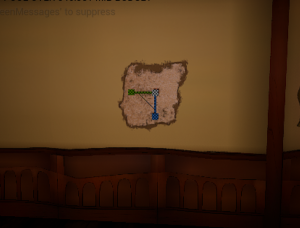Week 5 consisted of looking at the process of texturing and its many strategies. We have many assets that require a texture. From our tasks we learnt the different ways to apply textures in UE, and the different ways to apply textures to a mesh. Overall these methods helped with our texturing stage on Substance Painter, and applying textures on UE.



Image 1: Applying Decals
Image 2: Working with materials & Instances
Image 3: Texturing with layers on Substance Painter
Source:
https://learning.ulster.ac.uk/webapps/blackboard/content/listContent.jsp?course_id=_323028_1&content_id=_6114034_1
https://learning.ulster.ac.uk/webapps/blackboard/content/listContent.jsp?course_id=_323028_1&content_id=_6271359_1
We also had a lecture on ‘Designing a pipeline based on an art style’ from Michael.
Art style possibilities are endless:
- There is not just only ‘realistic’ or ‘stylised’. There is a massive range in-between and beyond. etc. the many art styles of Link / the legend of Zelda – all can tell the mood of the storyline
- Outside of games and VFX, ‘realistic’ is almost non-existent in Animation. ‘Realistic’ animations that exist to require fantastical elements to define its style.
Every artistic version is also a technical challenge
- A good director is not just someone with a vision,, but someone who knows how to clearly communicate that vision to others
- One person may have a style without thinking of it. However for a team it must be defined, communicated and maintained throughout a project. An Art directors role consists of this.
How do they ‘define’ an art style?
- What is the shape language? sharp lines? Soft or rounded? Elongated shapes? Cluttered and busy or minimalist?
- What is the colour scheme, what are the rules for creating new colour schemes within the world? Pastel colours or saturated or monochrome?
- What makes our character look like they do? Design references or existing art styles. Be specific. What do they eyes look in th world? What will the hair look like? what are the Childs proportions compared to an adults or animals proportions?
- Define the painted style, ink? watercolour? oil? flat colours? Is black allowed, or never? What will the lighting look like?
The more questions you answer the better you understand your art,
and easier to communicate with others.
Art directors create style guides to emphasise key do’s and don’t’s to pass the rule on to the team.
Source: https://ericreimer.com/art-direction-enviromental-style-guide
This art direction art style guide made by Eric Reimer allows their team to be aware of the preferences and stylistic approaches of the project. They have designed the mood and setting of the environment in a game perspective, included references, and breakdowns of each part of the environment to further explain the uses. This is a great way to communicate an art style to others.
It also needs to be translated step by step to reach its final form etc. concept, sculpt, model texture, rig – light. With coherency, consistency, in a technically achievable way. Figuring out how is the job of a Technical director.
How does a technical director do this?
Consists of experimentation and testing, critical evaluation and comparison.
What to evaluate?
- How closely does the test render match the style?
- Is the style still good/appealing after translated into 3D?
- What changes can be made to make the art style suit 3D better?
- What software best helps us reach the result?
- was they’re technical limitations to be aware of?
- How difficult was it to achieve?
Tech direction will then develop a pipeline in detail for other artists. This will encompass every aspect of producing an animated sequence that style is accurate to the project – They will provide:
- Shader / material with correct setting where artists can swap textures for each asset
- Animation cycles that can be loaded and edited for different shots
- Light rigs for sets to serve as a starting point
- Modular models
- Reference models
- Custom starting scenes with correct render settings
Lastly, the Lead artists will work together with the art and tech director to develop, or set starting points of models, textures and lighting guides for each team – to emphasise the particular approach needed in each department.
This was an interesting lecture to listen to – it definitely gave me and my group a second thought of how we were approaching our art style, and to find a style we can all adjust to.
After this weeks lecture, I started on creating the texture of the wallpaper for the room walls. I was able to make this texture using the tasks from this weeks lesson on texturing – mostly grasping the idea of making a ‘Seamless Texture’ which helped create the effect of a repetitive pattern.
The explanation of the wallpaper design is on this post: